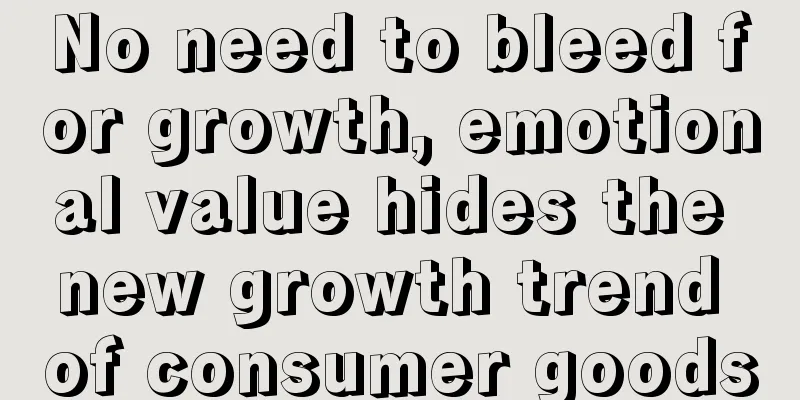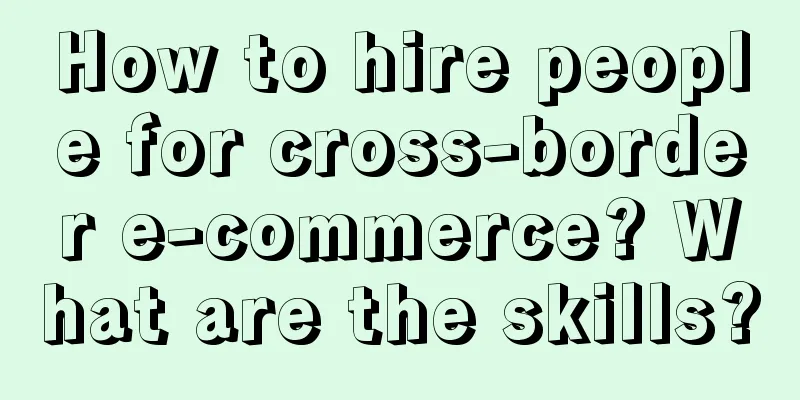No need to bleed for growth, emotional value hides the new growth trend of consumer goods

The concept of emotional value is very popular, but what is its relationship with brand growth? What are the application scenarios and strategies? This article breaks it down. The emergence of this incident is mainly due to changes in the background of the times and user needs. 1. Times and users are changing. Be aware before you act.1. From a production-oriented society to a consumption-oriented societyLet me first state the conclusion: the production-oriented model focuses on commodity supply and pays more attention to function and use value; the consumption-oriented model focuses on user demand and pays more attention to spiritual and emotional value. Production-oriented companies pursue scale and efficiency, so channels are king. As long as the channels are laid out, products can be sold steadily, and it is difficult for competitors to enter, and the barriers are high. Nongfu Spring and Wahaha are strong in channels, and Yuanqi Forest, as a latecomer, has to invest a lot of money to get a share. This is a successful case of breaking through, and there are too many that died halfway. The consumer type is user-centric, which is reflected in the focus on changes in user characteristics and needs. For example, from large families to small families, from married to living alone, from mass to individual, from ordinary to quality, these are all changes in user characteristics, and consumer needs will certainly change accordingly. They pursue more spirit, culture, appearance, and niche, represented by coffee (Santonban), sweeping robots (Ecovacs, Dreame), and healthy diet (Super Bowl, Yuanqi Forest). In a consumer society, emotional value is central. Being able to sell products, have brand recognition, and generate profits is a breakthrough direction for differentiation. In short, the transition from production to consumption is the transition from functional value to emotional value. Behind this is the user demand triggered by economic development and changes in social trends. Brands should follow this trend and provide users with new product supplies. 2. The generational differences among those born after 1995 determine the importance of self-pleasure needsLet me first state the conclusion: those born after 1995 are the main consumer group, and the need to please themselves is the most significant differentiating feature. Generation Z (born between 1995 and 2009) has a population of 260 million and an annual consumer expenditure of nearly RMB 5 trillion. This group not only has strong spending power, but also represents consumer trends. If you want to capture this group of people, you need to understand this group: Simply put, the material needs of those born after 1995 are not the core, their spiritual needs are more important. In the era of slow growth, involution, anxiety, and confusion are common phenomena. In addition, they are the second generation of only children, and the size of the extended family has become smaller, making them lonelier than previous generations. In addition, their work and life are dependent on mobile Internet, which aggravates their loneliness. These problems need to be internalized and solved, so the need to please oneself is the emotional outlet for those born after 1995. 2. Emotion vs. Function, the Two Ends of User DemandWhat is emotional value and how do we understand this concept? It means literally, so there is no need to explain it in detail. But it can be explained from another perspective: what is not emotional value, or what is the opposite. Emotional value vs functional value, as shown in the figure: 1) Functional value: just need, buy rationally. Quality is the premise, cost performance is the key. For example, for basic consumer goods, such as food, beverages, and household care products, the functions themselves are user demands, and the competition among brands mainly lies in product cost-effectiveness and sales channels. Brands must maximize production and sales efficiency and adopt a competitive strategy of overall cost leadership. The pain point is that they are all competing in the existing market, which is a zero-sum game. Products are highly homogenized and competition in the industry is fierce. Pricing power is relatively weak and profit margins are low. 2) Emotional value: It is not a rigid demand, but an emotional consumption. It is a new demand of new groups and has an emotional premium. Compared with functional value, it is a new scene, new selling point, and new function, because satisfying emotional value is also another function. It can be an independent selling point or superimposed on functional value. To create emotional value, we must create content, emphasizing the expression of brand concepts and the shaping of demand scenarios. The advantages are that the brand has a premium, high user awareness, is far away from price wars, users have no demand for cost-effectiveness, and profits are guaranteed. The pain point is that it is not a rigid demand, the marketing cost is high, and the conversion efficiency is relatively low. Users of some categories buy randomly, and some are impulse purchases. Functional value vs. emotional value is not static and there is no clear dividing line. Instead, there are two directions with emphasis. Each brand can focus on a certain direction, and the specific degree is also optional. Even functional value can be transformed into emotional value, in two cases: 1) Functional value plus emotional value can create differentiation and increase average order value or profit. Ordinary writing pens are considered as a symbol of study pressure in the eyes of primary school students. If the pen body is added with Ultraman IP, it will increase the emotional value. It makes people happy and everyone wants to get this pen. It also has social value and can be used for exchange or given as a gift. 2) Transform from functional value to emotional value, completely cross categories, enter new tracks and become new categories. Parents buy Xiaotiancai watches for their children's safety. However, the product has social functions similar to WeChat, as well as virtual currency, step counting, games, music and other tools, which make children addicted. It is similar to adults using their phones every day. If it is just a positioning tool, it will not bring much benefit to children and is just a demand of parents. But after adding social and game functions, the category essentially becomes a children's phone. It is indeed fun. In addition, only watches of the same brand can be added as friends, so the purchase initiators of Xiaotiancai have changed from parents to children. It solves the problem of separation between purchasing decision makers and users, and drives product sales more smoothly and powerfully. It is good for the brand, but it creates new troubles for parents. 3. Addiction, society, self-pleasing, and the classification of emotional valuesUsers' emotional values are divided into three categories: addictive, social, and self-pleasing. 1. Addictive type: dopamine often makes people happy and relaxedThere are two parts: leisure products such as cigarettes, alcohol, coffee, and tea; and basic products such as sugar, oil, and spicy food. After ingestion, dopamine is produced, which brings a sense of pleasure and is addictive. But when doing marketing, you can’t directly stimulate users’ addiction, you have to use a roundabout strategy. There are two ways to do this: 1) create a scene, 2) divert firepower. Let’s talk about creating a scene first, taking the wine category as an example. Although alcohol can stimulate dopamine nerves to release dopamine, making people happy and relaxed, which can be considered a functional attribute, the Advertising Law has strict requirements, "It is not allowed to explicitly or implicitly state that drinking alcohol can eliminate tension and anxiety, increase physical strength, etc.", so marketing must not start from this perspective. Avoid functional attributes and focus on emotional value. The marketing of alcohol is mainly focused on the scene. For example, gatherings with friends, holiday celebrations, cultural experiences, food pairings, etc., all have emotional value. The emotional value here, combined with the addictive nature of alcohol, is the most powerful purchasing motivation. Let’s talk about shifting firepower, let’s take sugar as an example. According to current consumer habits, this product is unhealthy. You must not talk about its functional properties when marketing it, as this will scare people and make them worry about harming their health. The solution is to use content to introduce new selling points and divert attention. Yuanqi Forest emphasizes 0 sugar, 0 fat, and 0 calories, while Snickers is about sweeping away hunger. Both cater to people's emotions and combine product selling points to tell more acceptable stories. Similarly, the words "bubbles", "freshness" and "smoothness" are used in advertising slogans to give people a sugar-free taste and delicious experience. Of course, shifting focus does not change the characteristics of the category. The general direction of emotional value must be continued and it must be consistent with the essence of the category to conform to user perception and be logical. 2. Social: users’ social identity and sense of belongingHumans are social animals who have a need to find their social position, tend to establish connections and a sense of belonging with others, and seek self-identity. All consumption behaviors related to this have emotional value. The current situation is that the social circles of contemporary young people have become smaller and they have fewer friends. There are many reasons, one of which is very important, as mentioned above: those born after 1995 are the only child 2.0, and their extended families have become smaller, meaning that there are fewer cousins of the same generation. Moreover, as mobile Internet natives, mobile phones have solved most of the problems, weakening the social scene. The social circle is solidified, social skills are poor and the social cost is high, which leads to the inability to meet social needs in real life. However, the need to seek social recognition does exist, so young people try other ways, such as consumer behaviors with social attributes. They buy luxury goods, gold jewelry, trendy brand clothing, etc. to show their identity in their circle and relieve the pressure brought by loneliness. Taking luxury goods as an example, there is a clear trend of younger consumer users. Xiaohongshu has a research report that shows 62.3% of its users have been paying attention to luxury goods before the age of 22, and 19.1% of its consumers are students. For young people, buying luxury goods is like watching a carnival in a live broadcast room. It is the simplest and most direct way to enhance their status and voice. It is also a tool to integrate into social circles and meet the needs of emotional value. I have previously given a four-quadrant definition to explain emotional value, as shown in the figure above. Luxury goods and gold jewelry are categories with high emotional value and high decision-making costs. Grasping this characteristic, the core of brand growth is definitely not cost-effectiveness, but to help users find social recognition and a sense of belonging, and successfully play the role of social currency. This is the correct path. 3. Self-pleasing type: spending money on yourself is the most worthwhileIf the social type is more outward-oriented, then pleasing oneself is inward-oriented, making oneself happy, which is an emotional value. There is one insight that is particularly typical. In the past, people didn't care about their underwear and socks because they were worn inside and could not be seen by outsiders. They were generally cheap, of low quality, and not necessarily comfortable to wear. Things have changed now. People pursue the quality and comfort of underwear. Although others cannot see it, their own feelings are also very important. This is the need to please themselves. China Youth Daily established the China Youth School Media, which is dedicated to researching and serving college students. Their research data: 83.02% of young people spend money for the purpose of "self-pleasure/inner satisfaction"; 95.26% of young people think it is worth spending money on niche hobbies. Judging from the trend, self-pleasing is an important factor in young people's consumption, which also proves the key position of emotional value in consumption decisions. Typical categories of self-pleasing consumption include cosmetics, fragrances, home furnishings, medical beauty, pets, etc. The common point is that the main beneficiaries are themselves. When growing a brand, it is necessary to combine products with scenarios and present them with content. Don’t let users focus only on the product. Help them enter the “usage scenario after owning the product”, give them room for imagination, and let them feel pleasure in advance. For example, a large double sofa can be placed in the living room, where you can lie down and watch a movie with your lover after get off work; you can go back to the bedroom, dim the lights, smell the light fragrance of the perfume, put on a facial mask, watch a few short videos, and then go to sleep... Learn to understand users, especially the new demands of those born after 1995; also make good use of content to give users room for imagination to experience the product. IV. Two cases: Laopu Gold and Bawang Tea PrincessCase 1: Laopu Gold, a new national luxury product for young peopleThe name of this brand is a bit rustic, but they are using the "luxury brand approach" to make this golden product. The young colleagues were all attracted to it, and the emotional value was maximized, which was particularly in line with the topic of this research. 1. Let’s talk about the gold jewelry industry first 1) International and domestic brands occupy the high-end and low-end markets respectively The high-end market of gold jewelry has long been monopolized by international brands such as Cartier, Tiffany, and Bulgari, and the brand itself is the moat. Domestic brands such as Chow Tai Fook, Chow Tai Seng, and Lao Feng Xiang are positioned in the mass consumer market, cutting into a different market from foreign brands. 2) Entering an innovation growth cycle after 2020 Before 2020, the main demand for buying gold jewelry was for wedding occasions, but it also had investment and collection value. After that, it entered an innovation and growth cycle, and non-wedding demands such as self-pleasing and gift-giving grew rapidly. Users made purchases because they liked the design style or product concept, which was a typical self-pleasing demand. 3) The trend is younger users and lower-end channels The main consumer group has changed from those born in the 60s, 70s and 80s to Generation Z. Fewer people are getting married, and there are no relatives or friends to give gifts to, so people are mainly focusing on themselves. In addition, brands are opening stores in lower-tier cities, and the popularity of live streaming e-commerce has pushed the channel down to the grassroots. 2. Let me introduce the brand of Laopu Gold It was just listed on the Hong Kong Stock Exchange on June 28. It mainly designs, produces and sells ancient gold products. In 2023, its revenue was 3.178 billion and its net profit was 416 million, up 145.6% and 337.9% year-on-year respectively. All in all, this hot IPO company has seen a good growth momentum. Facing industry competition, Laopu Gold has done the following: 1) Positioning high-end luxury goods The Hermes of gold, other brands sell for 700 yuan per gram, but Laopu gold can be sold for 1,400, doubling its value. The product is positioned as a high-end luxury product, turning gold into a collectible with a premium. It combines fashion and traditional culture very well, which is different from other domestic brands and meets the preferences of young users. 2) Ancient gold takes advantage of the national trend Young users like Generation Z have boosted the rise of the national trend style. China's traditional culture is very popular in all fields, bringing new growth points. Products made using ancient craftsmanship such as Laopu Gold, with the help of the national trend, demonstrate the diversification trend of China's luxury goods market. The essence of this is users' confidence in and recognition of local culture, which can bring growth. 3) Younger users and higher net worth Laopu Gold is positioned as a high-end luxury product, and its users are high-net-worth individuals. This is also verified by the data: their average customer consumption from 2021 to 2023 is more than 30,000 yuan. High net worth users need channels to reach them, and the logic behind Laopu Gold’s location selection is also very clear. In first-tier and new first-tier cities such as Beijing, Shanghai, Shenzhen, Hong Kong, and Macau, 32 directly-operated stores have been opened. And their stores are all located in high-end department stores in prime locations, covering 8 of the top 10 high-end department stores in the country. In summary, this new national trend luxury positioning for young people has lost the old-fashioned design and rigid wedding demands of the past, and is clearly moving towards a new growth curve of emotional value. The users’ recommendation and purchase are the internal release of emotional value. Sharing on social platforms is the external search for recognition: Such graphic and text content magnifies the advantages of the product and makes everyone who sees it excited. If the product is good, the content only needs to play the role of a channel to expand from point to surface. Users will follow the flow and spontaneously follow, promote, buy and share. Case 2: Bawang Tea Princess, the application of emotional value in marketingThis brand is so popular that it is the fastest growing tea brand in recent years, no doubt about it. The GMV in 2023 is 10.8 billion, and it is expected to exceed 20 billion this year. So far, 4,500 stores have been opened, with relatively few SKUs, mainly original leaf fresh milk tea. The hot-selling single product is Boya Juexian, which can sell 230 million cups a year. The above is the basic situation of the brand. Here we will only talk about "the application of emotional value in products and marketing." It must be pointed out that some of the analysis conclusions may not be intentional, but may be encountered by chance. However, they may also be inspiring to those who are doing research and studying. 1. Category selection-addiction type The new tea brands that were popular before all had the attributes of Internet celebrities. Their peak moments only lasted for 1-2 years, and then they declined and returned to their normal state. Some brands were not in their normal state, so they collapsed. This has to do with the category. If you drink too much sweet things, you will get sick of them, so they are definitely not consumed frequently. But coffee and tea are fine to drink every day. The reason is as mentioned above, products like tea and coffee are addictive. When Bawang Chaji entered the market, she chose full-leaf tea instead of fruit tea. The intuitive feeling is the taste and mouthfeel. It is not so irritating to drink, but also relieves greasiness, which can support the frequency of consumption. From a physiological point of view, the addiction type mainly comes from caffeine, which has a refreshing effect and also produces dopamine, which may improve mood and make people feel happy. This is not the only reason why Bawang Chaji has achieved this scale. After all, there are other tea brands with similar positioning. When we analyze cases, we will try to think about them in all aspects. The following are several other representative key points. 2. Luxury goods reference - self-pleasure type When people in the industry mention Ba Wang Cha Ji, they always talk about one topic, which is the "reference" of design elements from luxury brands. Bawang Cha Ji combines the designs of Dior and LV, making users feel that entering this store and holding a paper cup instantly gives them a sense of luxury, which is brought about by luxury design elements. Dior is just a pole, and Bawang Cha Ji climbs up along it. The function of luxury goods is not only to please oneself, but also to gain recognition from a certain circle of people, which are both manifestations of emotional value. Let's extend this a little bit and talk about the issue of plagiarism. We cannot simply define whether plagiarism is right or wrong. Instead, we need to look at why we plagiarize, how we plagiarize, and what we do afterwards. If you just pursue short-term results, copy and make money immediately, and then argue for the next one, without accumulation and follow-up, this is definitely not recommended. If you want to learn from successful cases, inspire and help yourself to land faster and take fewer detours, it is logical from a business perspective. This view applies not only to Bawang Cha Ji, but also to products such as Xiaomi SU7. 3. Making friends over tea - social type The category of tea has cultural and social attributes. Bawang Cha Ji is positioned as tea, proposing to meet friends from all over the world through oriental tea, and also publishing interactive content and activities on various social platforms. We have specially created an independent mini-program called "Tea Friends Community", and the official name for users is also tea friends. There are also peripheral products such as badges, refrigerator magnets, mobile phone wallpapers, blankets, as well as joint activities with China National Geographic, the Forbidden City, and museums, which are also strengthening the cultural and social attributes of this brand. In fact, it is just a cup of milk tea, a consumer product, but the brand's profoundness and emotional connection are integrated and spread through such elements. In summary, many of the things that Bawang Cha Ji does in marketing are related to emotional value. Focus on health, allowing users to enjoy the pleasure brought by dopamine without guilt; engage in joint brands, with strong IP or luxury goods endorsements, so that users can find identification with their circle; build social networks, penetrate brand awareness, and increase stickiness of user networks. That’s all, let me summarize. The emergence of emotional value is a trend and a real user demand. We should do a good job of user insights, combine our own products and advantages to develop strategies, and seize this wave of growth opportunities. |
<<: The return rate of women's clothing e-commerce is 80%. Who is being driven crazy?
>>: Dong Yuhui, you can't learn it.
Recommend
Is it good to open a store on a cross-border e-commerce platform? What are the advantages?
Many businesses have set their sights on foreign c...
100 Keyword Predictions for 2023 | Branding and Marketing (31-40): Metaverse, Nature Directors and Agelessness
WPP's brand Wunderman Intelligence released it...
How does marketing guru Lei Jun grasp consumer psychology?
Xiaomi Motors' first model, SU7, was officiall...
Xiaohongshu 7 types of business operation strategy V1.0
If you are confused and lost about the marketing o...
Oracle closes its advertising business unit: a cross-border journey of ambition and frustration
Why did Oracle close its advertising business unit...
Platform mental status and usage guidelines
This article introduces four common platforms in o...
Estimated future DAU
This article teaches you how to use DAU and APRU t...
Where can I apply for a cargo transportation conditions certificate? How long is it valid?
In foreign trade, if the goods are to be transport...
How can the catering industry be absent from the traffic of the European Cup?
Why has the emergence of the European Cup made foo...
Xiaohongshu's local life is still playing with the ticket period
At present, the popularity of group buying has not...
User behavior analysis, this is the most practical guide I have ever seen!
User behavior analysis is an important part of dat...
Xiaohongshu’s copywriting is amazing!
618 is coming soon, and Xiaohongshu's promotio...
Sharing of classic copywriting sentences, which can be applied
Copywriting is an important part of product promot...
The "ice cream assassin" that fell in the scorching heat is being replaced by Gelato
Affordable ice cream has become the mainstream, an...
Entering the trillion-dollar market, is selling coffee the beginning of group buying on Xiaohongshu?
Recently, the local life business official account...









